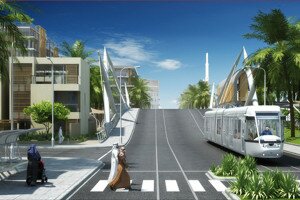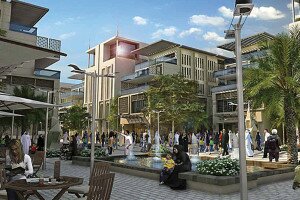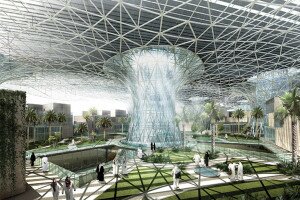Back in 2006, work started on a comprehensive set of strategic policies for the development of the Emirate. The results appeared in 2007 and received praise from planners and policy-makers around the world. So how is the plan progressing?
The aims of Abu Dhabi Vision 2030 were partly social and partly economic; to use the booming oil revenues wisely to create a sound economy, to make Abu Dhabi a great place to live, learn and do business, and to create an environment that respected the past while setting new standards for the future.
Abu Dhabi Vision 2030 provides an overarching statement of direction. Individual government entities and the major enterprises of Abu Dhabi have all been developing their own strategies in line with those goals. But the two most important and most extensive are the Abu Dhabi Economic Vision 2030 from the Abu Dhabi Council for Economic Development (ADCED), and the Abu Dhabi Urban Planning Vision 2030 from the Abu Dhabi Urban Planning Council (UPC, which was created specifically for the purpose).
Both include a lot of detail about where we’re going and how we are going to get there. Both took effect in 2008 too, and after the first five years they are ripe for reappraisal.
In fact 2008 was an unfortunate starting point, the year of the US credit crunch and the start of a global economic slowdown that included falls in oil prices and tougher credit markets. As a result, some of the initial Vision 2030 ideas had to be revised – though not the basic principles.
Urban Planning
The Urban Planning Vision 2030 is one of the best-documented government plans you will find anywhere in the world. It’s notable for the level of detail, for instance in the Urban Street Design Manual – design standards that include integrated transport (pedestrians, public transport, cars, waterbuses) but also covers the placement of streetlights, traffic signs and benches.
This is exceptional work, oriented towards a pedestrian-friendly lifestyle (shading and cooling on city streets, for instance) with metro and tram systems to complement (and maybe displace) the car. It’s also a longer-term vision; there’s no evidence yet of the tram system that was originally due to start service in 2014, for instance.
Trams and metro
The current plan is for a $7bn tram and metro system to appear in 2017 and be fully operational in 2020. It’s all part of the Department of Transport’s Surface Transport Master Plan, which includes 130km of metro and 340km of tram lines.
The first phase of metro will run for 18km between Zayed Sports City and Al Mena, mostly underground, with 17 stations. The first two tram lines will run between Marina Mall and Reem Island (15km) and the Bus Station to Saadiyat (13km).
There’s a good chance that this will happen – the first tenders are reportedly due to be awarded early next year, and bidders are already queuing up.
Estidama
Estidama began life in 2010 as a policy programme that invites developers to subscribe to a code of values for environmental sustainability in buildings. But it also incorporates a rating system called Pearl, and all new projects (communities as well as individual buildings) must comply with this.
The ratings system is regarded as a landmark, equivalent to the better established but regionally irrelevant European and American systems like LEED.
New urban areas
Plans for Saadiyat, Yas, Sowwah and Reem Islands predated the Vision 2030 project, and work was also underway on expansion of the suburbs – notably Mohammed Bin Zayed City and Khalifa A. These have all been incorporated into the broader strategy of the Urban Development Plan, along with some significant land-use elements.
National parks: there will be no development in a number of protected areas, particularly ‘fingers’ of land reaching into the desert from the coastline along the road to Dubai. There will also be absolute protection between Yas and Saadiyat Islands.
Capital City: a new masterplanned area for government offices, universities and other state entities will fit between Khalifa City and MBZ City. Right now this has the sweeping new Zayed University campus and the older ADU buildings but little else.
Central Business District: the prime areas around the Corniche and on to Sowwah are being earmarked as the downtown business area. This is one of the parts of the capital where high-rise towers are permitted – there’s a height restriction for much of Abu Dhabi – and you can see the effects already.
Cultural tourism: The development of Saadiyat’s museums was put on hold for a couple of years, but the Louvre Abu Dhabi is underway for a targeted opening on national Day 2015. The Zayed National Museum will follow in 2016 and the Guggenheim is due in 2017. Two other projects from the original announcements are less certain; the maritime museum and a performing arts centre.
Renewables
Masdar, the Abu Dhabi Future Energy Company, was a typically visionary commitment. It has seen investment in the Masdar Institute of Technology, aiming to develop a generation of national and international researchers in renewables; Masdar City, the environmentally sustainable development out by the airport which houses the Institute and is growing to include other significant tenants – like IRENA, the International Renewable Energy Agency; large-scale clean energy projects like Shams 1 near Madinat Zayed, the world’s largest concentrated solar power plant; and targeted investments in renewables companies around the world.
Masdar has had to scale back some of its activities in the global economic slowdown, with Masdar City in particular losing some of its pricey low- and no-impact elements while the pace of building has been slowed considerably. But it’s still a significant force for the future, and the 100MW capacity means Shams 1 will contribute significantly to Abu Dhabi’s energy needs (Shams 2 and 3 should follow).
Manufacturing
The recently opened Kizad industrial zone is likely to be an important source of growth for the Emirate. Abu Dhabi’s General Holding Corporation, the UAE’s largest industrial conglomerate, has invested heavily in aluminium and other key sectors.
Economic diversification
The other areas for government investment in the next five-year period are media (especially with more development for the twofour54 free trade zone where Abu Dhabi Week is based), health care, petrochemicals, aviation, and financial services.
All of these are already seeing grassroots change, being driven especially by clever public-private partnerships. One interesting element of the current thinking is that property is not mentioned – unlike Dubai, where property development is regarded as a key part of the future, it seems Abu Dhabi has decided on a more substantial and more sustainable path.
LAND USE FRAMEWORK






















